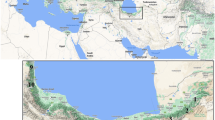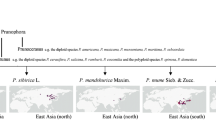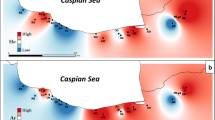Abstract
The present study investigated genetic diversity, structure and hybridization in a collection of the endangered wild pear species Pyrus pyraster (L.) Burgd. A total of 278 putative ‘true type’ P. pyraster trees originating from seven populations in the federal state of Saxony in Germany were analyzed along with 35 pear cultivars commonly cultivated in Saxony. The genetic analysis was performed using nine nuclear microsatellite markers (ncSSR) and two paternally inherited chloroplast marker (cpDNA) amplifying in the intergenic spacer region trnQ–rps16 and the intron region rps16. On basis of the ncSSR dataset after STRUCTURE analysis 80 % of the wild pear individuals were assigned as ‘true type’ P. pyraster genotypes. The cpDNA analysis showed shared haplotypes in P. pyraster and P. communis but with an unequal frequency in both species. The analysis of molecular variance resulted in a moderate (ncSSR) and great (cpDNA) variation among ‘true type’ P. pyraster and the pear cultivars. The genetic diversity in the ‘true type’ P. pyraster populations was still high and the genetic structure between the populations low (ncSSR and cpDNA) indicating a genetic exchange between the populations by pollen and seeds. The clear discrimination between the P. pyraster and P. communis confirms our expectation of the existence of ‘true type’ P. pyraster individuals in the study area. The existing genetic integrity and the high genetic diversity argue for the implementation of preservation measures in P. pyraster.

Similar content being viewed by others
References
Albaladejo R, Guzman B, Gonzalez-Martinez S, Aparicio A (2012) Extensive pollen flow but few pollen donors and high reproductive variance in an extremely fragmented landscape. PLoS One 7(11):e49012
Allendorf FW, Leary RF, Spruell P, Wenburg JK (2001) The problems with hybrids: setting conservation guidelines. Trends Ecol Evol 16:613–622
Ashley M (2010) Plant parentage, pollination, and dispersal: how DNA microsatellites have altered the landscape. Crit Rev Plant Sci 29:148–161
Beaumont MA, Nichols RA (1996) Evaluating loci for use in the genetic analysis of population structure. Proc R Soc Lond B: Biol Sci 263:1619–1626
Bell RL, Hough LF (1986) Interspecific and intergeneric hybridization of Pyrus. Hortic Sci 21:62–64
Bell RL, Quamme HA, Layne REC, Skirvin RM (1996) Pears. In: Janick J, Moore JN (eds) Fruit breeding, vol I, Tree and tropical fruitsWiley, New York, pp 441–514
Chase MW, Hills HH (1991) Silica-gel—an ideal material for field preservation of leaf samples for DNA studies. Taxon 40(2):215–220
Currat M, Ruedi M, Petit RJ, Excoffier L (2008) The hidden side of invasions: massive introgression by local genes. Evolution 62:1908–1920
De Nettancourt D (2001) Incompatibility and incongruity in wild and cultivated plants. Springer, Berlin
Dolatowski J, Nowosielsi J, Podyma W, Szymanska M, Zych M (2004) Molecular studies on the variability of Polish semi-wild pears (Pyrus) using AFLP. J Fruit Orn Plant Res 12:331–337
Ebert D, Peakall R (2009) A new set of universal de novo sequencing primers for extensive coverage of noncoding chloroplast DNA: new opportunities for phylogenetic studies and cpSSR discovery. Mol Ecol Resour 9(3):777–783. doi:10.1111/j.1755-0998.2008.02320.x
Ennos R (1994) Estimating the relative rates of pollen and seed migration among plant populations. Heredity 72:250–259
Fernandez-Fernandez F, Harvey NG, James CM (2006) Isolation and characterization of polymorphic microsatellite markers from European pear (Pyrus communis L.). Mol Ecol Notes 6(4):1039–1041. doi:10.1111/j.1471-8286.2006.01422.x
Fogelqvist J, Verkhozina AV, Katyshev AI, Pucholt P, Dixelius C, Rönnberg-Wästljung AC, Lascoux M, Berlin S (2015) Genetic and morphological evidence for introgression between three species of willows. BMC Evol Biol 15:193. doi:10.1186/s12862-015-0461-7
Glässer N, Wissemann V (2005) Morphometrische Populationsstudien zur Abgrenzung natürlicher Vorkommen der Wildbirne Pyrus pyraster (L.) Burgsd. von verwilderten Kulturbirnen P. communis (L.) (Maloideae, Rosaceae) im Mittleren Saaletal, Thüringen. Mitt Dtsch Dendrol Ges 90:67–84
Godbout J, Yeh FC, Bousquet J (2012) Large-scale asymmetric introgression of cytoplasmic DNA reveals holocene range displacement in a North American boreal pine complex. Ecol Evol 2(8):1853–1866. doi:10.1002/ece3.294
Godt MJW, Caplow F, Hamrick JL (2005) Allozyme diversity in the federally threatened golden paintbrush, Castilleya levisecta (Scrophulariaceae). Conserv Genet 6:87–99
Gouesnard B, Bataillon TM, Decoux G, Rozale C, Schoen DJ, David JL (2001) MSTRAT: an algorithm for building germ plasm core collections by maximizing allelic or phenotypic richness. J Hered 92(1):93–94
Heinze B (2007) A database of PCR primers for the chloroplast genomes of higher plants. Plant Methods 3:4. doi:10.1186/1746-4811-3-4
Iketani H, Katayama H, Uematsu C, Mase N, Sato Y, Yamamoto T (2012) Genetic structure of East Asian cultivated pears (Pyrus spp.) and their reclassification in accordance with the nomenclature of cultivated plants. Plant Syst Evol 298:1689–1700. doi:10.1007/s00606-012-0670-0
Katayama H, Uematsu C (2003) Comparative analysis of chloroplast DNA in Pyrus species: physical map and gene localization. Theor Appl Genet 106(2):303–310
Kim KW, Chung HK, Cho GT, Ma KH, Chandrabalan D, Gwag JG, Kim TS, Cho EG, Park YJ (2007) PowerCore: a program applying the advanced M strategy with a heuristic search for establishing core sets. Bioinformatics 23(16):2155–2162
Koopman W, Li Y, Coart E, De Van, Weg E, Vosman B, Roldan-Ruiz I, Smulders MJM (2007) Linked vs. unlinked markers: multilocus microsatellite haplotype-sharing as a tool to estimate gene flow and introgression. Mol Ecol 16(2):243–256
Korotkova N, Nauheimer L, Ter-Voskanyan H, Allgaier M, Borsch T (2014) Variability among the most rapidly evolving plastid genomic regions is lineage-specific: implications of pairwise genome comparisons in Pyrus (Rosaceae) and other Angiosperms for marker choice. PLoS One 9(11):e112998. doi:10.1371/journal.pone.0112998
Kramer AT, Ison JL, Ashley MV, Howe HF (2008) The paradox of forest fragmentation genetics. Conserv Biol 22(4):878–885
Layne REC, Quamme HA (1975) Pears. In: Janick J, Moore JN (eds) Advances in fruit breeding. University Press, West Lafayette, pp 38–70
Liebhard R, Gianfranceschi L, Koller B, Ryder CD, Tarchini R, van de Weg E, Gessler C (2002) Development and characterization of 140 new microsatellites in apple (Malus × domestica Borkh.). Mol Breed 10(4):217–241
Luan S, Chiang TY, Gong X (2006) High genetic diversity vs. low genetic differentiation in Nouelia insignis (Asteraceae), a narrowly distributed and endemic species in China, revealed by ISSR fingerprinting. Ann Bot 98(3):583–589. doi:10.1093/aob/mcl129
Mantel N (1967) Adaptation of Karber’s method for estimating the exponential parameter from quantal data, and its relationship to birth, death, and branching processes. Biometrics 23(4):739–746
Neigel J (2002) Is FST obsolete? Conserv Genet 3:167–173
Nevill PG, Després T, Bayly MJ, Bossinger G, Ades PK (2014) Shared phylogeographic patterns and widespread chloroplast haplotype sharing in Eucalyptus species with different ecological tolerances. Tree Genet Genomes. doi:10.1007/s11295-014-0744-y
Palme AE, Su Q, Palsson S, Lascoux M (2004) Extensive sharing of chloroplast haplotypes among European birches indicates hybridization among Betula pendula, B. pubescens and B. nana. Mol Ecol 13(1):167–178
Peakall R, Smouse PE (2006) GENALEX 6: genetic analysis in Excel. Population genetic software for teaching and research. Mol Ecol Notes 6(1):288–295
Peakall R, Smouse PE (2012) GENALEX 6.5: genetic analysis in Excel. Population genetic software for teaching and research—an update. Bioinformatics 28(19):2537–2539
Porth I, El-Kassaby YA (2014) Assessment of the genetic diversity in forest tree populations using molecular markers. Diversity 6:283–295
Pritchard JK, Stephens M, Donnelly P (2000) Inference of population structure using multilocus genotype data. Genetics 155:945–959
Reim S, Proft A, Heinz S, Lochschmidt F, Höfer M, Tröber U, Wolf H (2015) Pollen movement in a Malus sylvestris population and conclusions for conservation measures. Plant Genet Res: Charact Util. doi:10.1017/S1479262115000301
Rugienius R, Blazyte A, Lukoseviciute V, Siksnianiene JB, Frercks B, Gelvonauskiene D, Gelvonauskis B, Sasnauskas A, Baniulis D, Stany V (2013) Genetic polymorphism of wild pear accessions collected in Lithuania. Balt For 19(1):13–21
Stephan R, Wagner I, Kleinschmit J (2003) Technical guidelines for genetic conservation and use for wild apple and pear (Malus sylvestris and Pyrus pyraster). EUFORGEN International Plant Genetic Research Institute, Rome
Terakami S, Matsumura Y, Kurita K, Kanamori H, Katayose Y, Yamamoto T et al. (2012) Complete sequence of the chloroplast genome from pear (Pyrus pyrifolia): genome structure and comparative analysis. Tree Genet Genomes 8:1–14. doi:10.1007/s11295-012-0469-8
Wagner I (1995) Identifikation von Wildapfel (Malus sylvestris (L.) Mill.) und Wildbirne (Pyrus pyraster (L.) Burgsd.). Forstarchiv 66:39–47
Wagner I (1996) Zusammenstellung morphologischer Merkmale und ihrer Ausprägung zur Unterscheidung von Wild- und Kulturformen des Apfels (Malus) und des Birnbaumes (Pyrus). Mitt Dtsch Dendrol Ges 82:87–108
Weir BS, Cockerham CC (1984) Estimating F-statistics for the analysis of population structure. Evolution 38:1358–1370. doi:10.2307/2408641
Whitlock MC, McCauley DE (1999) Indirect measures of gene flow and migration: FST not equal to 1/(4Nm + 1). Heredity 82(2):117–125
Wilding CS, Grahame J, Mill PJ (2000) Mitochondrial DNA CoI haplotype variation in sibling species of rough periwinkles. Heredity 85:62–74. doi:10.1046/j.1365-2540.2000.00718.x
Wolko L, Bocianowski J, Antkowiak W, Słomski R (2015) Genetic diversity and population structure of wild pear (Pyrus pyraster (L.) Burgsd.) in Poland. Open Life Sci 10:19–29
Zeven AC, Zhukovsky PM (1975) Dictionary of cultivated plants and their centres of diversity. Centre for Agricultural Publishing and Documentation, Wageningen, p 2
Zheng X, Cai D, Potter D, Postman J, Liu J, Teng Y (2014) Phylogeny and evolutionary histories of Pyrus L. revealed by phylogenetic trees and networks based on data from multiple DNA sequences. Mol Phylogenet Evol 80:54–65
Zohary D, Hopf M (2000) Domestication of plants in the Old World, 3rd edn. Oxford University Press, Oxford, p 316
Acknowledgments
This work was financially supported by the German Federal Ministry of Food and Agriculture (BMEL) through the Federal Office for Agriculture and Food (BLE), grant number 2810BM018 and 2810BM025. We thank Claudia Wiedow for her helpful comments. We also thank Monika Höfer from the Julius Kühn Institute in Dresden-Pillnitz for providing the pear cultivar samples.
Author information
Authors and Affiliations
Corresponding author
Rights and permissions
About this article
Cite this article
Reim, S., Lochschmidt, F., Proft, A. et al. Species delimitation, genetic diversity and structure of the European indigenous wild pear (Pyrus pyraster) in Saxony, Germany. Genet Resour Crop Evol 64, 1075–1085 (2017). https://doi.org/10.1007/s10722-016-0426-8
Received:
Accepted:
Published:
Issue Date:
DOI: https://doi.org/10.1007/s10722-016-0426-8




